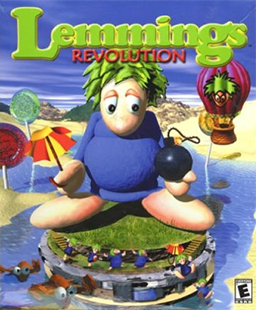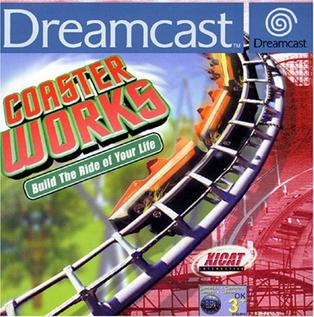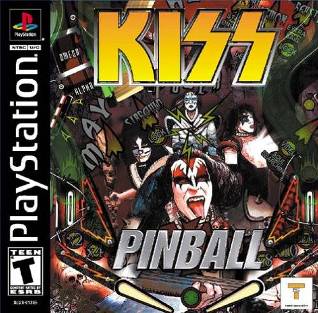
Europa Universalis is a grand strategy video game developed by Paradox Development Studio and published in 2000 by Strategy First.

Hidden & Dangerous is a 1999 tactical shooter video game developed by Illusion Softworks and published by Take-Two Interactive and TalonSoft for Windows, Dreamcast and PlayStation. The PlayStation port of the game was developed by Tarantula Studios. It is regarded as a pioneering tactical shooter. A sequel, Hidden & Dangerous 2, was released in 2003.

Lemmings Revolution is a puzzle video game released in 2000. Like previous games in the Lemmings series, the object of the game is to guide the lemmings characters to an exit by giving them specific skills. Each level is situated on a rotating cylinder, so while the game is displayed in 3D, it plays much more like the 2D games.

Coaster Works, known in Japan as Jet Coaster Dream, is a simulation game for the Dreamcast console published by Bimboosoft. The game is a simulation of roller coaster design and construction. Each of the levels offer certain requirements that the player must meet to pass to the next level. The game starts the player off in a "kiddie" themed park and progresses to more and more difficult levels with more difficult requirements. A direct sequel titled Jet Coaster Dream 2 was released on November 2, 2000 in Japan only as the North American and PAL releases were cancelled for 2001. A third game titled Rollercoaster World was developed by Takara and published by D3 Publisher in Japan as Simple 2000 Series Vol. 33: The Jet Coaster on July 24, 2003, and by Midas Interactive Entertainment in Europe on May 21, 2004 for the PlayStation 2.

F-1 World Grand Prix, developed by Paradigm Entertainment, is a Formula One racing game/sim first released in 1998 for the Nintendo 64 game console and to later platforms including the Sega Dreamcast, Microsoft Windows, Sony PlayStation, and Game Boy Color. The Nintendo 64 version is based on the 1997 Formula One season, featuring each of the 17 circuits from the season and all 22 drivers, with the exceptions of Jacques Villeneuve and the MasterCard Lola team.

Corsairs: Conquest at Sea, also known as simply Corsairs, is a 1999 strategy/action/adventure game for the PC, developed and published by Microïds. The game is a simulation of the life of a privateer employed by either England, France, The Netherlands or Spain in, most likely, the 17th century. The player can take part in either the campaign, which consists of several scenarios with a specific goal, or adventure mode, where the goal is simply to capture all the ports on the map for their nation.

Ultimate Ride is a video game by Disney Interactive for Microsoft Windows in which players design, engineer and ride virtual roller coasters.

Blaze & Blade: Eternal Quest, also known as simply Blaze & Blade, is a multiplayer action role-playing game developed by T&E Soft for the PlayStation and Microsoft Windows. It is the first in the series, and the only one released outside Japan.

Rage of Mages is a PC game that combines role-playing and real-time strategy. Produced by Nival Interactive it was first released in Russia under the name of Allods: The Seal of Mystery. The game was published in April 1998 in the EU by Buka Entertainment and on October 13, 1998 in the US. It was re-released in 2016 on GOG.com.

Muppet RaceMania is a PlayStation racing game based on The Muppets franchise that was developed by Traveller's Tales and released in 2000.

X-COM: Enforcer is the sixth game in the X-COM series, but takes place in a time line separate to that was established by the first four games of the series. Enforcer is an action third-person shooter without the strategy game elements of previous games. It was the last game released in the series until Firaxis Games' 2012 reboot.

The Emperor's New Groove is the name of two video games based on the 2000 Disney movie of the same name, one developed by Argonaut Games for the PlayStation and Microsoft Windows and the other by Sandbox Studios for the Game Boy Color.

Wild Metal Country is an action video game developed by DMA Design. The game was published by Gremlin Interactive and released for Microsoft Windows in May 1999. A Dreamcast port, known as Wild Metal, was released in February 2000 by Rockstar Games, which later also re-released the Windows version.

Adventure Pinball: Forgotten Island is a pinball video game released in 2001 by Electronic Arts for Microsoft Windows.

America is a real-time strategy game developed by Related Designs and published by Data Becker, released in December 2000 and January 2001 to mixed reviews. Set in a post-civil war America, the game plays similarly to Age of Empires. The player may choose to control a group of either settlers, Native Americans, Mexicans or outlaws of that time.

Carnivores: Ice Age is a first-person shooter video game developed by Action Forms and published by WizardWorks for Microsoft Windows. It is the third game in the Carnivores series. Unlike the previous games, in which the player must hunt dinosaurs, Carnivores: Ice Age allows the player to stalk large Cenozoic animals such as mammoths and saber-toothed cats. In 2011, the game was ported to iOS and Android devices by Tatem Games, and to PlayStation Portable by WizardWorks.

Creatures is an artificial life simulation packaged as a video game developed by British studio Creature Labs for Windows, and was ported to Macintosh, PlayStation, and Game Boy Advance. It is the first game in the Creatures series.

KISS Pinball is a video game developed by Wildfire Studios and published by On Deck Interactive for Microsoft Windows in 2000. A port for PlayStation, developed by Tarantula Studios, was released by Take-Two Interactive in 2001.
NBA Inside Drive is a series of video games based on National Basketball Association, published by Microsoft Studios. Its main competition was NBA Live, a series from Electronic Arts.

Official Formula 1 Racing is a racing game developed by Lankhor and published by Eidos Interactive in 1999. A sequel to the game, called F1 World Grand Prix, was released in 1999–2000.




















